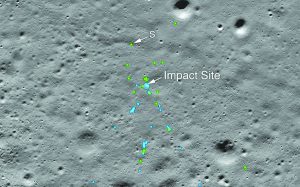 A Chennai-based techie, who helped NASA trace the debris of India’s ambitious lunar mission by spending hours comparing before and after images of the landing site is a hero. This has been confirmed by the US space agency, which found Chandrayaan-2’s Vikram lander that crashed on the surface of the Moon in September.
A Chennai-based techie, who helped NASA trace the debris of India’s ambitious lunar mission by spending hours comparing before and after images of the landing site is a hero. This has been confirmed by the US space agency, which found Chandrayaan-2’s Vikram lander that crashed on the surface of the Moon in September.
NASA’s confirmation came nearly three months after India’s Chandrayaan-2 mission made a hard landing near the uncharted lunar south pole in the wee hours of September 7. “The Chandrayaan2 Vikram lander has been found by our NASA Moon mission, the Lunar Reconnaissance Orbiter. See the first mosaic of the impact site,” NASA said in a tweet sharing before and after impact images.
On September 7, the Indian Space Research Organisation (ISRO) attempted a soft landing of Vikram on the Moon. However, ISRO lost contact with Vikram shortly before the scheduled touchdown. NASA’s Lunar Reconnaissance Orbiter Camera (LROC) team had released the first mosaic of images acquired during its September 17 flyby of the Moon.
The US space agency released a mosaic image of the site on September 26 (but taken on September 17), inviting people to compare it with images of the same area before the crash to find signs of the lander. The first person to come up with a positive identification was Chennai-based IT professional Shanmuga Subramanian, who confirmed the identification of the crashing site of Vikram by comparing before and after images. “The debris first located by Shanmuga is about 750 metres northwest of the main crash site and was a single bright pixel identification in that first mosaic,” NASA said.
After receiving this tip, the LROC team confirmed the identification by comparing the before and after images. “When the images for the first mosaic were acquired the impact point was poorly illuminated and thus not easily identifiable,” NASA said in a statement, adding that two subsequent image sequences were acquired on October 14 and 15, and November 11. The LROC team scoured the surrounding area in these new
mosaics and found the impact point about 2,500 feet to the southeast of the planned touchdown site, and a spray of debris emanating outward.
The November mosaic had the best pixel scale (0.7 metre) and lighting conditions (72 degrees incidence angle), NASA said. “The November mosaic shows best the impact crater, ray and extensive debris field. The three largest pieces of debris are each about 2×2 pixels and cast a one pixel shadow,” the statement said.
On October 3, Subramanian, a Chennai-based mechanical engineer, had tagged the twitter handles of NASA, LRO and ISRO in a tweet, asking, “Is this Vikram lander? (1 km from the landing spot) Lander might have been buried in Lunar sand?”. On November 17, he further zeroed in on his observations and tweeted out the possible crash site of the lander.
“This might be Vikram lander’s crash site (Lat:-70.8552 Lon:21.71233 ) & the ejecta that was thrown out of it might have landed over here … (The one on the left side was taken on July 16th & one on the right side was from Sept 17),” he said in a tweet accompanying the images. As it turns out, Subramanian was spot on with his inferences, and now NASA has lauded him for finding the lander. “NASA has credited me for finding Vikram Lander on Moon’s surface VikramLander Chandrayaan2,” Subramanian said in another tweet.
“Thank you for your email informing us of your discovery of debris from the Vikram lander. The LROC team confirmed that the location does exhibit changes in images taken before and after the date of the landing,” said deputy project scientist Lunar Reconnaissance Orbiter mission John Keller. “Using this information, the LROC team did additional searches in the area and located the site of the primary impact as well as other debris around the impact location and has announced the sighting on the NASA and ASU pages where you have been given credit for your observation.”
“I apologise for the delay in getting back to you. We needed to be certain of our interpretation of the observation as well as making sure that all stakeholders had an opportunity to comment before we could before we could announce the results. Congratulations for what i am sure was a lot of time and effort on your part,” the scientist in his letter to Subramanian who shared it on Twitter.
While it cannot be said that Subramanian was not credited him for his find, many said that he had “helped” NASA find the lander, or that the space body had discovered the missing lander.
Indeed, even NASA had tweeted earlier saying that “the #Chandrayaan2 Vikram lander has
been found by our @NASAMoon mission, the Lunar Reconnaissance Orbiter.”
Anand Mahindra meanwhile took to Twitter to call out those who he believes are not giving due credit to Subramanian. On December 3, the Chennai techie had tweeted stating that NASA had credited him “for finding Vikram Lander on Moon’s surface”.
Mahindra responded to the tweet by asking why Subramanian was not getting the credit he deserves. “Why aren’t the headlines reading ‘Indian engineer discovers Vikram Lander debris. NASA confirms finding?’ Can’t we give enough credit to our own tech wizards?” he asked.
However, not everyone was in agreement. As one Twitter user put it, “He used NASA’s images to find location. Now do you think it’s possible without those maps?” “Don’t be salty,” the user told Mahindra.
The latter however had a ready response. Citing India’s ancient invention of the concept of ‘zero’, Mahindra said that in that case “every prize-winning mathematician should give the credit to India”.
Ever since ISRO lost contact with Vikram, NASA had made several attempts to locate the Chandrayaan-2 lander with the help of its Lunar Reconnaissance Orbiter. The LRO flew over Vikram’s landing site once on September 17 and next on October 14.
Chandrayaan-2 mission to the Moon was launched in July. Had the spacecraft reached the surface in one piece on September 7, India would have been only the fourth country to successfully put a lander on the Moon.
letters@tehelka.com













